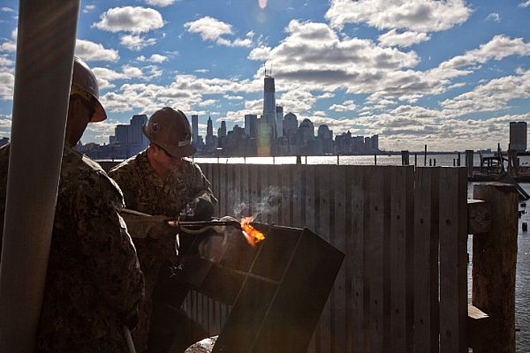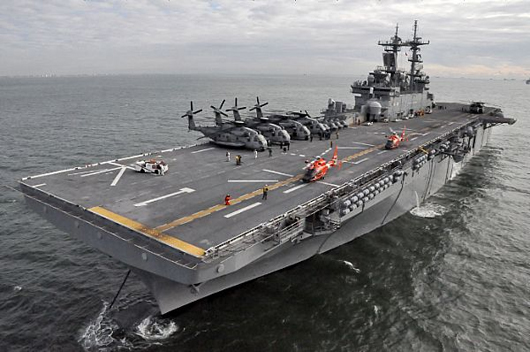US Navy Provides Disaster Relief In The Aftermath Of Hurricane Sandy
The U.S. Navy continued to provide disaster relief in support of the Federal Emergency Management Agency (FEMA), national and local authorities in the New York and New Jersey areas affected by Hurricane Sandy, Nov. 4.
USS Wasp (LHA 1), USS San Antonio (LPD 17), and USS Carter Hall (LSD 50) are in position off the coast of New York and New Jersey supplying military personnel and equipment to disaster areas.
Wasp is supplying aircraft to aid in the mission with a total of 18 helicopters aboard: - two SH-60s
- four MH-53Es
- six CH-53Es
- six UH-1Ns
and
- one MH-53

U.S. Navy Seabee works to repair pier facilities in Hobobken, N.J. The U.S. Navy has positioned forces in the area to assist U.S. Northern Command (NORTHCOM) in support of FEMA and local civil authorities following the destruction caused by Hurricane Sandy. (U.S. Marine Corps photo by Cpl. Bryan Nygaard/Released)
Several of these helos have departed for Joint Base McGuire-Dix-Lakehurst (JB MDL) for tasking.
Wasp also sent a team of damage controlmen and hull technicians to help repair the damaged Hoboken Ferry Terminal.
San Antonio has four MH-60S and a landing utility craft (LCU) capable of transporting cargo, vehicles and personnel from ship to shore.
Carter Hall also has an LCU capable of transporting cargo, vehicles and personnel from ship to shore. This LCU ferried supplies and personnel ashore to Sandy Hook, N.J., Nov. 4.
Both San Antonio and Carter Hall are capable of providing command and control; underwater infrastructure repair capabilities; riverine search and damage assessment; and underwater port survey.
Construction Battalion Maintenance Unit 202, embarked aboard San Antonio and Carter Hall, is providing two 15 kilowatt generators and three 250 gallons per minute (gpm) pumps. Additionally, they are providing small boat and command and control support to the U.S. Coast Guard.
Kanawha, a Henry J. Kaiser-class fleet replenishment oiler, got underway Nov. 2 and will operate in the open waters east of recovery operations. This logistics ship will ensure that Navy and Marine Corps forces are self-sustained with food and fuel.
Navy Mobile Construction Battalion (NMCB) 11 is providing a convoy of 23 vehicles and 90 Seabees prepared to assist. Their equipment includes five 60 kilowatt, five 30 kilowatt and three 15 kilowatt generators and six 725 gpm pumps along with one 1,000 gpm pump.
NMCB 5 is providing 110 Seabees to JB MDL for tasking.

Two Coast Guard Dolphin HH-65C Helicopter's land aboard the amphibious assault ship USS Wasp (LHD 1)
FEMA issued a mission assignment to the Department of Defense requesting "high-volume water pumps (350 gpm and greater) with qualified teams to support the operation and maintenance of the equipment."
In support of FEMA, the Secretary of Defense has authorized the Navy to provide 30 high-volume pumps, 125 Sailors and 30 civilian technicians to support dewatering efforts. So far, 18 Sailors from Mobile Diving and Salvage Units have arrived, with an additional 110 Sailors and 30 pumps from NMCB 5 to arrive Nov. 5.
Source:
U.S. Navy
TOP
|